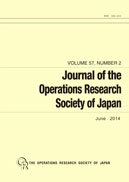Volume 41, Issue 2
Displaying 1-16 of 16 articles from this issue
- |<
- <
- 1
- >
- >|
-
Article type: Cover
1998Volume 41Issue 2 Pages Cover4-
Published: 1998
Released on J-STAGE: June 27, 2017
Download PDF (16K) -
Article type: Appendix
1998Volume 41Issue 2 Pages App3-
Published: 1998
Released on J-STAGE: June 27, 2017
Download PDF (59K) -
Article type: Article
1998Volume 41Issue 2 Pages 171-180
Published: 1998
Released on J-STAGE: June 27, 2017
Download PDF (579K) -
Article type: Article
1998Volume 41Issue 2 Pages 181-195
Published: 1998
Released on J-STAGE: June 27, 2017
Download PDF (826K) -
Article type: Article
1998Volume 41Issue 2 Pages 196-213
Published: 1998
Released on J-STAGE: June 27, 2017
Download PDF (1357K) -
Article type: Article
1998Volume 41Issue 2 Pages 214-228
Published: 1998
Released on J-STAGE: June 27, 2017
Download PDF (1387K) -
Article type: Article
1998Volume 41Issue 2 Pages 229-245
Published: 1998
Released on J-STAGE: June 27, 2017
Download PDF (1690K) -
Article type: Article
1998Volume 41Issue 2 Pages 246-260
Published: 1998
Released on J-STAGE: June 27, 2017
Download PDF (1276K) -
Article type: Article
1998Volume 41Issue 2 Pages 261-278
Published: 1998
Released on J-STAGE: June 27, 2017
Download PDF (1712K) -
Article type: Article
1998Volume 41Issue 2 Pages 279-288
Published: 1998
Released on J-STAGE: June 27, 2017
Download PDF (937K) -
Article type: Article
1998Volume 41Issue 2 Pages 289-310
Published: 1998
Released on J-STAGE: June 27, 2017
Download PDF (1997K) -
Article type: Article
1998Volume 41Issue 2 Pages 311-328
Published: 1998
Released on J-STAGE: June 27, 2017
Download PDF (1242K) -
Article type: Appendix
1998Volume 41Issue 2 Pages 329-331
Published: 1998
Released on J-STAGE: June 27, 2017
Download PDF (286K) -
Article type: Appendix
1998Volume 41Issue 2 Pages App4-
Published: 1998
Released on J-STAGE: June 27, 2017
Download PDF (76K) -
Article type: Cover
1998Volume 41Issue 2 Pages Cover5-
Published: 1998
Released on J-STAGE: June 27, 2017
Download PDF (59K) -
Article type: Cover
1998Volume 41Issue 2 Pages Cover6-
Published: 1998
Released on J-STAGE: June 27, 2017
Download PDF (59K)
- |<
- <
- 1
- >
- >|
